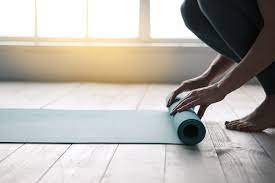[ad_1]
The Ultimate Guide to Cleaning and Maintaining Your Yoga Mat
Yoga mats are essential tools for practicing yoga, providing comfort, support, and stability during poses and movements. Over time, however, these mats can accumulate dirt, sweat, oils, and bacteria, making it necessary to clean and maintain them regularly. Proper care will not only keep your mat smelling fresh and hygienic but also extend its lifespan. In this ultimate guide, we will walk you through the step-by-step process of cleaning and maintaining your yoga mat.
1. Know Your Mat: Understanding the material of your yoga mat is crucial as different materials require different cleaning methods. Most mats are made from PVC, rubber, cork, or natural fibers like cotton and jute. Check the manufacturer’s instructions or website to determine the specifics of your mat.
2. Daily Maintenance: To keep your mat in top condition, develop a daily maintenance routine. After each practice, wipe down your mat with a soft cloth to remove any sweat and dirt. This quick wipe will prevent dirt from seeping into the mat’s surface, making the weekly cleaning process easier.
3. Weekly Deep Cleaning: Once a week, deep clean your yoga mat to remove any embedded dirt and bacteria. Begin by filling a bathtub or large basin with warm water and a small amount of mild soap or a specifically formulated yoga mat cleaner. Submerge the mat in the water and gently agitate it, ensuring all areas are thoroughly cleaned. Avoid using excessive force to prevent mat damage.
4. Different Materials, Different Methods: As mentioned earlier, different materials require various cleaning methods. For PVC and rubber mats, a mild soap solution is usually sufficient. Avoid using harsh chemicals, as they can deteriorate the material and compromise your grip. For natural fiber mats, a solution of warm water and vinegar is effective in neutralizing odor and removing stains.

5. Drying: After cleaning, rinse your mat with clean water to remove any soap residue. Roll your mat up and press it gently to squeeze out excess water. Avoid wringing or twisting the mat, as this can damage the material. Lay your mat flat on a clean towel and roll it up together, pressing firmly to absorb additional moisture. Finally, unroll the mat and hang it to air dry in a well-ventilated area, avoiding direct sunlight to prevent color fading.
6. Alternative Cleaning Methods: If you don’t have access to a bathtub or prefer not to submerge your mat, there are alternative cleaning methods. A spray bottle filled with a yoga mat cleaner solution can be used to mist the mat. Wipe it down with a soft cloth or sponge, then wipe with a clean, damp cloth to remove any cleaning residue. Allow the mat to air dry before rolling it up for storage.
7. Storage: Proper storage is essential for maintaining your mat’s shape and prolonging its lifespan. Avoid storing your mat in direct sunlight or extreme temperatures, as this can weaken the material and cause fading. Roll your mat gently, avoiding any sharp bends or creases. Some mats come with straps or carry bags for convenience, protecting your mat from dirt, dust, and moisture.
8. Remove Odors: If your mat starts to develop an unpleasant odor, there are simple solutions to tackle this issue. Sprinkle baking soda or a specifically formulated yoga mat deodorizer onto your mat, let it sit for a few minutes, then wipe it off with a damp cloth or sponge. This process will help absorb and neutralize any odors, leaving your mat fresh and fragrant.
9. Mat Accessories: Using a yoga towel or mat cleaner spray during practice can help maintain cleanliness. A yoga towel can provide an extra layer of absorbency, protecting your mat from sweat and dirt, while a mat cleaner spray can be used to sanitize the mat surface during exercise breaks.
10. Replace When Necessary: Despite proper care and maintenance, yoga mats will eventually wear out over time. Signs of wear include fraying edges, decreased grip, and thinning material. If your mat starts to deteriorate or becomes excessively slippery, it is time to invest in a new one to ensure optimal safety and comfort during your yoga practice.
By following this ultimate guide to cleaning and maintaining your yoga mat, you can ensure a clean, hygienic, and long-lasting practice surface. Regular cleaning and maintenance not only provide a more pleasant experience but also help to safeguard your health and well-being. So, roll out your mat, practice mindfulness, and enjoy your yoga journey!
[ad_2]




